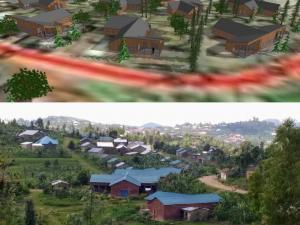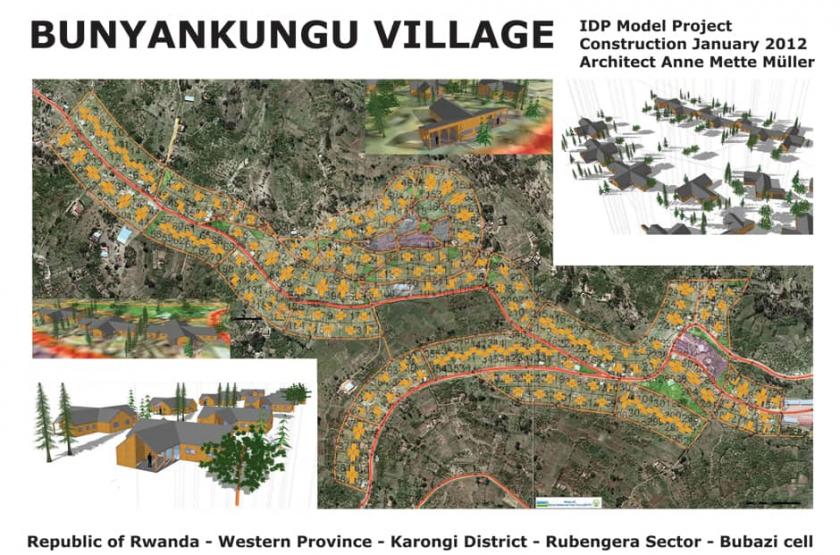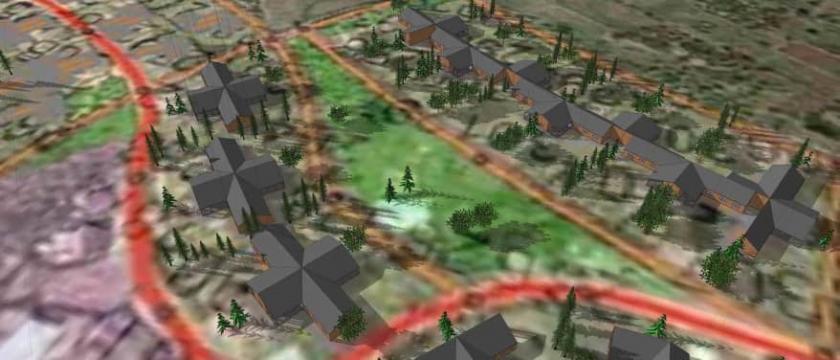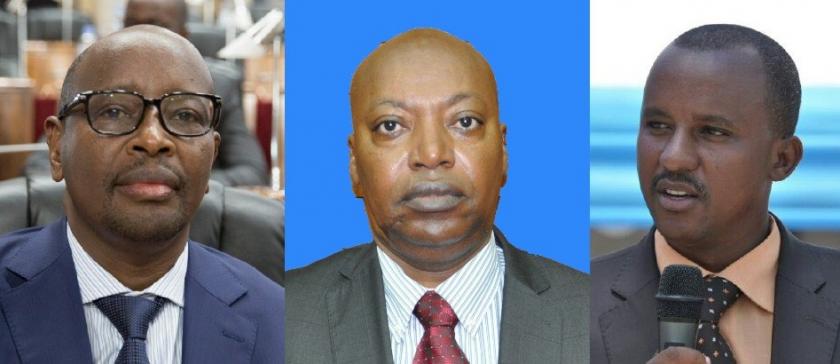
Daylight Robbery: Local Government Ministry Planned for 384 Houses Model Village in Karongi, Only 11 Houses Built
Nine years ago, Government of Rwanda through the Local Government Ministry got some funding for a unique model housing village in Karongi district from ADRA, the global humanitarian arm of the Seventh Day Adventist Church. Today, the site for the village stands as an ugly reminder of how a good cause turned terribly wrong.
The plan on paper was to construct 384 houses in different formats as: "Four-in-One" where each block has 4 houses; "Twin" which is a block with 2 houses; and Single houses. These houses would settle 1,500 people. There would be a kindergarten, Cell office, health facility and a host of other social amenities. It would have been some kind of heaven in rural Rwanda.
According to original planning, the pilot project was to build 384 houses, with a possibility of increasing the project to 700 units. It was called the Bunyankungu model village located in Bubazi cell, Rubengera sector of Karongi district. If it succeeded, the model would be replicated in other districts of the Western Province.
In 2011, the Local Government Ministry, Westerm Province and Karongi district settled on the project in collaboration with ADRA, the Seventh Day Adventist agency. The latter was to provide some of the funding, another portion coming from government.
At the time, the Local Government Minister was James Musoni, who was humiliatingly fired from cabinet in April 2018. He would a few months later be sent to Zimbabwe as envoy to date. The Western Province Governor was Celestin Kabahizi, who moved to regional Parliament EALA in October 2013. He resigned two years later under unclear circumstances. We did not establish his current whereabouts.
The mayor of Karongi district was Bernard Kayumba, another trouble-ridden individual. In early 2015, Kayumba resigned. Days later, he was arrested and prosecuted over fraudulent activities found in the management of health insurance funds. He would later be acquitted.
The central government, western provincial officials and ADRA also settled on an architectural design of the model village submitted by a Danish national. The design concept of the village was simply breathtaking, to say the least, as seen from the images we have published.
The details about this project have been close to impossible to obtain. None of the agencies involved have released any information about it, like how design was chosen, total budget and expenses. A report done by the Ombudsman in 2018 has questionable data, and doesn't reflect the facts on the ground in Karongi district.
But despite the information blackout over this project, a joint team involving Radio ISANGANO and The Chronicles, found some people willing to speak. We had to promise them anonymity.
Danish architect gets contract


In 2011, design and all logistics had been finalised. A committee comprising opinion leaders and local officials was constituted to act as the supervisor of the construction process, according to our sources. They were not architects, but selected due to their roles in society.
Every aspect was flowing as planned and construction got underway the same year. The supervisory committee and Danish architect - with local construction teams, moved quickly.
By end of 2013, two years later, construction was progressing. Trouble began surfacing. According to news reports from the time, construction and supervisory teams were dismissed. Payments were made to people whose names were not on original list. Architect Anne Mette Müller resigned and left Rwanda.
On her blog, she wrote; “But unfortunately at that time it was not politically possible to continue our collaboration with the ....authorities in Rwanda”. Her architectural design, according to our sources, was immediately dropped through a decision adopted by provincial and district officials.
Work came to a standstill. Then a strange incident happened on the night of May 9, 2014. Security guard Simeon Kananiye was brutally killed at a facility in the village where all construction materials were stored including cement. The records book containing details of what got in and out of the warehouse, disappeared. It was kept in the facility.
By this time, only 11 houses had been completed. Here is a breakdown of the designs: Two "Twin" blocks each having 2 houses, one "Four-in-One" block with 4 houses and 3 "Single" houses. In total, these are 11 houses for 11 families.
It is these houses that stand in this village as of February 2020. But the village now also has other privately buit houses.
Bricks used instead of Hydraform blocks
One of the first problems with this model village is that original plan of using Hydraform blocks was abandoned before construction began, for small traditional bricks locally known as Rukarakara. The Rukarakara bricks are cheaper and readily available.
The original plan, as narrated to us by our source on the supervisory committee, each of the Four-in-one block would have cost Rwf 25m, the Twin block was to consume Rwf 12.5m, while the single houses were planned to cost Rwf 6m. At least, this was the PLAN.
The reality of the 11 houses that stand today is completely different. To determine if indeed the money planned was spent on each block/house, we engaged a construction consultant to do a cost-evaluation of the houses. We found a consultant with 44 years of experience on construction sites around Rwanda.
For the Twin block, the consultant tells us that looking at bricks used, wooden doors, the form of cement/sand mixture, and paints used, between Rwf 12m - 15m was spent. As for the Single houses, the consultant says building one of them can go for about Rwf 5m.
We noted a similarity between cost incurred for construction and the cost-evaluation by our consultant. It shows that the review by our consultant is within the margin of the planned designs. It also suggests the Danish architect and supervisory committee implemented the construction as planned.
According to our source, who was a senior member of the local supervisory committee, a total of Rwf 68m was spent on constructing these 11 houses.
The planned model village on paper was to have good roads connecting to other areas as it is located quite a distance from Karongi city center. It was to have green park, as well as green houses for fruits and vegetables. There was to be a cattle kraal for up to 80 hybrid cattle. NONE of all these facilities were constructed.
Each of the 11 houses completed and are standing today, has; 3 rooms and a living room, have electricity, don't have toilet (residents use common toilet), and don't have water (fetched away from village). The houses are currently occupied by people from historically marginalized community. All the houses have blue colored iron sheets.
Who is responsible for the mess?
As detailed above, the local government ministry knew all about the project since funding was channeled through it. As per government operations, the Western Provincial headquarters is overseer of all district activities, so was this project. The district was directly responsible since the village is located in its territory.
However, our source from the supervisory committee says when problems began arising and the project mysteriously stopped, mayor Kayumba and his district administration transferred the project to Rubengera sector and Bubazi cell. Basically, the district was abandoning all responsibility to avoid any future repercussions.

Our team managed to track down former Karongi district mayor Bernard Kayumba. In phone call on February 21, 2020, the writers informed him they were seeking to talk to him about the Karongi model village. He said he was driving and would call back in 1-hour and half. He did not. Our team called back after 3-hours, he did not pick the phone, and had not called back by press time.
As for ADRA agency which provided funding, our writers established contact with the human resource office based at headquarters in Kigali. The journalists were asked to send email with all questions, which would be forwarded to the ADRA Rwanda country director. The email was sent on February 4, 2020. No responses had been received by publication.
As for the Danish architect Anne Mette Müller, she did not respond to our Skype messages. However, she has a blog, on which details about the original planning are posted. There are graphic architectural designs of the model village. The blog can be accessed via (http://annemettemuller.com/work/rwanda/)
The current Karongi district mayor Mukarutesi Vestine, who only assumed office in September last year, following abrupt resignation of predecessor, doesn't seem to want to comment on the controversial project. Our writers contacted her last week via phonecall seeking appointment to discuss the project. She said we call her later to set time for meeting. She did not pick subsequent calls.
Ombudsman's conflicting details
Danish media also wrote about this model project when it was still at infancy stages, indication of the pride with Mette Müller's association to the project. In local media in Rwanda, it was splashed all over, promoted as a rare initiative by politicians.
But when the mess began emerging, not much information was available. With no specifics, the project died away from the media. Then, without warning, in November 2018, the Rwanda Investigation Bureau (RIB) announced it had opened investigation into the Karongi model village in response to report of the Ombudsman Anastase Murekezi.
However, our investigation has established that the information contained in the Ombudsman's report is doubtful. The facts on the ground are far different.

The Ombudsman report says the total budget of the project to construct the total 384 houses was Rwf 575 million ($616,000 in current exchange rate). We have not been able to independently verify this figures because it has never been written anywhere before. Not even in any of the media reports at the beginning, until it was announced by the Ombudsman in 2018.
Our estimates, using the Twin blocks of Rwf 15m as an example, takes the total budget to more than Rwf 2.8bn billion. This amount however doesn't include the social infrastructure that was to be built in the village. There is no doubt the planned budget for the project is in billions of Rwandan Francs.
The Ombudsman's report also contains a narrative that is factually wrong. The Ombudsman said 107 houses were built. This information, according to our sources in Karongi, is not true.
When the construction stopped in 2014, after completion of the 11 houses, local people in Karongi were sensitised to come and occupy the plots in the area. Our sources who were in the supervisory committee revealled that ordinary people began building own houses and were given some of the construction materials from the project's warehouse. They got cement, bricks and iron-sheets for roofing.
The additional 96 houses in the Ombudsman's report were not constructed as part of model village project. NO! They are houses built by current owners, who were only supported with a few of the materials. The district and province wanted to wash themselves of everything to do with the village project. Some of the current house owners actually paid for the materials, as they were cheap and on high demand.
"The other houses you see in the current village, except the 11 houses built by the project, were not put there by the project," said our source from the supervisory committee. "People got blue iron sheets and cement to build own houses. However, when the project had stopped, construction on some single houses was either at foundation level or walls. Those who took over the incomplete structures, completed them using their own money."
RIB also said at the time that as per Ombudsman report, Rwf 200m from total budget could not be justified by different people involved in the project. Since total cost is not factual, then one wonders where the Rwf 200m figure came from.
According to media reports from the time, seven unnamed people had been singled out and were being probed further by RIB. The project was "grossly mismanaged", said Ombudsman Murekezi.
“What we found out is that locals are living in unfinished houses and the designs of the houses were completely different,” added Murekezi.
From a summation the 384 houses that were planned, and only 11 built, the difference is a whopping 97% work not done. If, as indicated by our knowledgeable sources that the cost of building the completed houses was Rwf 68m, plus say an additional Rwf 100m in form of the remaining materials which were distributed, then those who stole from this project have their bank accounts full!
By Dushimimana Ngabo Emmanuel and Jean De Dieu Ntakirutimana/ Radio ISANGANO
